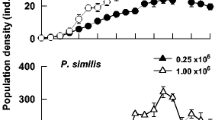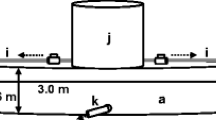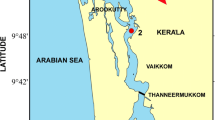Abstract
We examined the grazing rate of brine shrimp from Great Salt Lake, Utah (USA) at different life stages under varying water temperatures, salinities, and concentrations of two of their common phytoplankton foods: Dunaliella viridis and Coccochloris elabens. Trials for a brine shrimp life stage at a specific temperature, salinity, and food concentration occurred within 50 mL test tubes for 1 h; the difference between initial and final food concentrations represented grazing rate. General trends indicated grazing rate significantly increased with progressive life stages, increased with temperature, increased with food concentration, and decreased with salinity. Grazing rates for all life stages were greater on D. viridis compared to C. elabens. Brine shrimp life stages respond differently to environmental conditions. Specifically, while juveniles and adults varied their grazing rates in response to different food concentrations and salinities, nauplii grazing rate was not affected. Only adult grazing rates increased with increasing temperature. Differences in grazing rates under varying environmental conditions have implications for brine shrimp phenology, because brine shrimp populations in the Great Salt Lake are food limited in this highly variable environment.




Similar content being viewed by others
Notes
Conversions from food concentrations, experimentally measured as FSU, into cell densities (cells/ml) were based on the following equations: Dunaliella viridis: cells/ml = 754.26 × FSU – 740.91 (r 2 = 0.97, N = 12) and Coccochloris elabens: cells/ml = 15,639 × FSU + 35,984 (r 2 = 0.99, N = 60). The cell densities for D. viridis are low ~7179 cells/ml, medium ~27,921 cells/ml, and high ~55,829 cells/mL. For C. elabens the cell densities are low ~442,598 cells/ml, medium ~1,568,606 cells/ml, and high ~3,069,950 cells/ml.
References
Barnes, B. D. & W. A. Wurtsbaugh, 2015. The effects of salinity on plankton and benthic communities in the Great Salt Lake, Utah, USA: a microcosm experiment. Canadian Journal of Fisheries and Aquatic Sciences 72: 1–11.
Belovsky, G. E., & C. Larson, 2001. Brine shrimp population dynamics and sustainable harvesting in the Great Salt Lake, Utah: 2001 Progress Report to the Utah Division of Wildlife Resources, Salt Lake City, Utah.
Belovsky, G. E., D. Stephens, C. Perschon, P. Birdsey, D. Paul, D. Naftz, R. Baskin, C. Larson, C. Mellison, J. Luft, R. Mosley, H. Mahon, J. Van Leeuwen & D. V. Allen, 2011. The Great Salt Lake Ecosystem (Utah, USA): long term data and a structural equation approach. Ecosphere 2: 1–40.
Browne, R. A. & G. H. MacDonald, 1982. Biogeography of the brine shrimp, Artemia: distribution of parthenogenetic and sexual populations. Journal of Biogeography 9: 331–338.
Browne, R. A. & G. Wanigasekera, 2000. Combined effects of salinity and temperature on survival and reproduction of five species of Artemia. Journal of Experimental Marine Biology and Ecology 244: 29–44.
Costa, R. A. A. M., M. L. Koenig & L. C. C. Pereira, 2005. Feeding adult Artemia salina (Crustacea-Branchiopoda) on the dinoflagellate Gyrodinium corsicum (Gymnodiniales) and the Chryptophyta Rhodomonas baltica. Brazilian Archives of Biology and Technology 48: 581–587.
Dana, G. L., R. Jellison, J. M. Melack & G. L. Starrett, 1993. Relationships between Artemia monica life history characteristics and salinity. Hydrobiologia 263: 129–143.
Dana, G. L., R. Jellison & J. M. Melack, 1995. Effects of different natural regimes of temperature and food on survival, growth and development of Artemia monica Verrill. Journal of Plankton Research 17: 2117–2130.
Dasey, M., N. Ryan, J. Wilson, G. McGregor, L. Fabbro, B. A. Neilan, B. P. Burns, H. Kankaanpää, L. F. Morrison, G. A. Codd, D. Rissik & L. Bowling, 2005. Investigations into the taxonomy, toxicity and ecology of benthic cyanobacterial accumulations in Myall Lake, Australia. Marine and Freshwater Research 56: 1–11.
Datillo, A. M., L. Bracchini, L. Carlini, S. Loiselle & C. Rossi, 2005. Estimate of the effects of ultraviolet radiation on the mortality of Artemia franciscana in naupliar and adult stages. International Journal of Biometeorology 49: 388–395.
Engel, D. W. & J. W. Angelovic, 1968. The influence of salinity and temperature upon the respiration of brine shrimp nauplii. Comparative Biochemistry and Physiology 26: 749–752.
Evjemo, J. O. & Y. Olsen, 1999. Effect of food concentration on the growth and production rate of Artemia franciscana feeding on algae (T. iso). Journal of Experimental Marine Biology and Ecology 242: 273–296.
Evjemo, J. O., O. Vadstein & Y. Olsen, 2000. Feeding and assimilation kinetics of Artemia franciscana fed Isochrysis galbana (clone T. iso). Marine Biology 136: 1099–1109.
Irwin, S., V. Wall & J. Davenport, 2007. Measurement of temperature and salinity effects on oxygen consumption of Artemia franciscana K., measured using fibre-optic oxygen microsensors. Hydrobiologia 575: 109–115.
Kellogg, V. L., 1906. A new Artemia and its life conditions. Science 24: 594–596.
Loiterton, B., M. Sundbom & T. Vrede, 2004. Separating physical and physiological effects of temperature on zooplankton feeding rate. Aquatic Sciences 66: 123–129.
Makridis, P. & O. Vadstein, 1999. Food size selectivity of Artemia franciscana at three developmental stages. Journal of Plankton Research 21(11): 2191–2201.
Nambu, Z., S. Tanaka & F. Nambu, 2004. Influence of photoperiod and temperature on reproductive mode in the brine shrimp, Artemia franciscana. Journal of Experimental Zoology 301: 542–546.
Post, F. J., 1977. The microbial ecology of the Great Salt Lake. Microbial Ecology 3: 143–165.
Reeve, M. R., 1963a. The filter-feeding of Artemia I. In pure cultures of plant cells. Journal of Experimental Biology 40: 195–205.
Reeve, M. R., 1963b. The filter-feeding of Artemia II. In suspensions of various particles. Journal of Experimental Biology 40: 207–214.
Riisgård, H. U., D. Zalacáin, N. Jeune, J. B. Wiersma, F. Lüskow & D. Pleissner, 2015. Adaptation of the brine shrimp Artemia salina (Branchiopoda: Anostraca) to filter-feeding: effects of body size and temperature on filtration and respiration rates. Journal of Crustacean Biology 35: 650–658.
Vanhaecke, P., S. E. Siddall & P. Sorgeloos, 1984. International Study on Artemia. XXXII. Combined effects of temperature and salinity on the survival of Artemia of various geographic origin. Journal of Experimental Marine Biology and Ecology 80: 259–275.
Varo, I., A. C. Taylor & F. Amat, 1998. The effects of temperature and oxygen tension (PO2) on the oxygen consumption rates of adults of different Artemia strains. Comparative Biochemistry and Physiology Part A 120: 385–390.
Wetzel, R. G. & G. E. Likens, 1991. Limnological Analyses, 2nd ed. Springer, New York.
Wurtsbaugh, W. A., 1992. Food web modifications by an invertebrate predator in the Great Salt Lake (USA). Oecologia 89: 168–175.
Acknowledgements
We thank Erik Charette, Chelsea Nobriga, and Rebecca Flynn who helped to culture brine shrimp and phytoplankton used in experiments. We thank three anonymous reviewers for their comments and suggestions, which improved our manuscript. This material is based upon work supported by the National Science Foundation Graduate Research Fellowship Program (Sura) under Grant No. 1144087.
Author information
Authors and Affiliations
Corresponding author
Additional information
Handling editor: John M. Melack
Rights and permissions
About this article
Cite this article
Sura, S.A., Herlihy, N.S., Mahon, H.K. et al. Environmental impacts on grazing of different brine shrimp (Artemia franciscana) life stages. Hydrobiologia 792, 97–104 (2017). https://doi.org/10.1007/s10750-016-3047-5
Received:
Revised:
Accepted:
Published:
Issue Date:
DOI: https://doi.org/10.1007/s10750-016-3047-5




